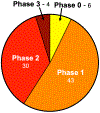Fluorescence Image-Guided Surgery - a Perspective on Contrast Agent Development
- PMID: 32255887
- PMCID: PMC7115043
- DOI: 10.1117/12.2545292
Fluorescence Image-Guided Surgery - a Perspective on Contrast Agent Development
Abstract
In the past several decades, a number of novel fluorescence image-guided surgery (FGS) contrast agents have been under development, with many in clinical translation and undergoing clinical trials. In this review, we have identified and summarized the contrast agents currently undergoing clinical translation. In total, 39 novel FGS contrast agents are being studied in 85 clinical trials. Four FGS contrast agents are currently being studied in phase III clinical trials and are poised to reach FDA approval within the next two to three years. Among all novel FGS contrast agents, a wide variety of probe types, targeting mechanisms, and fluorescence properties exists. Clinically available FGS imaging systems have been developed for FDA approved FGS contrast agents, and thus further clinical development is required to yield FGS imaging systems tuned for the variety of contrast agents in the clinical pipeline. Additionally, study of current FGS contrast agents for additional disease types and development of anatomy specific contrast agents is required to provide surgeons FGS tools for all surgical specialties and associated comorbidities. The work reviewed here represents a significant effort from many groups and further development of this promising technology will have an enormous impact on surgical outcomes across all specialties.
Keywords: clinical development; clinical trial; contrast agent; fluorescence; fluorescence imaging system; image-guided surgery; near-infrared fluorescence.
Figures




Similar articles
-
Improving precision surgery: A review of current intraoperative nerve tissue fluorescence imaging.Curr Opin Chem Biol. 2023 Oct;76:102361. doi: 10.1016/j.cbpa.2023.102361. Epub 2023 Jul 14. Curr Opin Chem Biol. 2023. PMID: 37454623 Free PMC article. Review.
-
Consensus conference statement on fluorescence-guided surgery (FGS) ESSO course on fluorescence-guided surgery.Eur J Surg Oncol. 2024 Feb;50(2):107317. doi: 10.1016/j.ejso.2023.107317. Epub 2023 Dec 12. Eur J Surg Oncol. 2024. PMID: 38104355
-
A Scoping Review of Ongoing Fluorescence-Guided Surgery Clinical Trials in Otolaryngology.Laryngoscope. 2022 Jan;132(1):36-44. doi: 10.1002/lary.29891. Epub 2021 Oct 11. Laryngoscope. 2022. PMID: 34633092
-
Matrix-designed bright near-infrared fluorophores for precision peripheral nerve imaging.Biomaterials. 2025 Aug;319:123190. doi: 10.1016/j.biomaterials.2025.123190. Epub 2025 Feb 15. Biomaterials. 2025. PMID: 39987852
-
State of the art medical devices for fluorescence-guided surgery (FGS): technical review and future developments.Surg Endosc. 2024 Nov;38(11):6227-6236. doi: 10.1007/s00464-024-11236-5. Epub 2024 Sep 18. Surg Endosc. 2024. PMID: 39294317 Free PMC article. Review.
Cited by
-
Anatase Titanium Dioxide Imparts Photoluminescent Properties to PA2200 Commercial 3D Printing Material to Generate Complex Optical Imaging Phantoms.Materials (Basel). 2021 Apr 6;14(7):1813. doi: 10.3390/ma14071813. Materials (Basel). 2021. PMID: 33917612 Free PMC article.
-
New hybrid radio-fluorescent probes [131I]-BPF-01 and [131I]-BPF-02 for visualisation of cancer cells: Synthesis and preliminary in vitro and ex vivo evaluations.Heliyon. 2023 Oct 5;9(10):e20710. doi: 10.1016/j.heliyon.2023.e20710. eCollection 2023 Oct. Heliyon. 2023. PMID: 37860547 Free PMC article.
-
Preferential Light-Chain Labeling of Native Monoclonal Antibodies Improves the Properties of Fluorophore Conjugates.Tetrahedron Lett. 2021 Jul 6;75:153211. doi: 10.1016/j.tetlet.2021.153211. Epub 2021 May 27. Tetrahedron Lett. 2021. PMID: 34321699 Free PMC article.
-
Introducing Fluorescence-Guided Surgery for Pediatric Ewing, Osteo-, and Rhabdomyosarcomas: A Literature Review.Biomedicines. 2021 Oct 4;9(10):1388. doi: 10.3390/biomedicines9101388. Biomedicines. 2021. PMID: 34680505 Free PMC article. Review.
-
Prospects for Fluorescence Molecular In Vivo Liquid Biopsy of Circulating Tumor Cells in Humans.Front Photon. 2022;3:910035. doi: 10.3389/fphot.2022.910035. Epub 2022 May 8. Front Photon. 2022. PMID: 39508030 Free PMC article.
References
-
- Sheridan RL, et al. Burn depth estimation by use of indocyanine green fluorescence: initial human trial. J Burn Care Rehabil 16, 602–604 (1995). - PubMed
-
- Hongo K, Kobayashi S, Okudera H, Hokama M & Nakagawa F Noninvasive cerebral optical spectroscopy: depth-resolved measurements of cerebral haemodynamics using indocyanine green. Neurol Res 17, 89–93 (1995). - PubMed
-
- Scheider A [Indocyanine green angiography with an infrared scanning laser ophthalmoscope. Initial clinical experiences]. Ophthalmologe 89, 27–33 (1992). - PubMed
-
- Arens C, Malzahn K, Dias O, Andrea M & Glanz H [Endoscopic imaging techniques in the diagnosis of laryngeal carcinoma and its precursor lesions]. Laryngorhinootologie 78, 685–691 (1999). - PubMed
Grants and funding
LinkOut - more resources
Full Text Sources
Other Literature Sources
Miscellaneous
